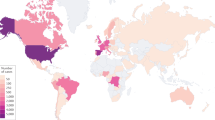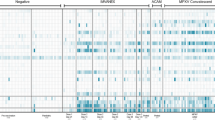Abstract
Approximately 50% of the US population received smallpox vaccinations before routine immunization ceased in 1972 for civilians and in 1990 for military personnel. Several studies have shown long-term immunity after smallpox vaccination, but skepticism remains as to whether this will translate into full protection against the onset of orthopoxvirus-induced disease. The US monkeypox outbreak of 2003 provided the opportunity to examine this issue. Using independent and internally validated diagnostic approaches with ≥95% sensitivity and ≥90% specificity for detecting clinical monkeypox infection, we identified three previously unreported cases of monkeypox in preimmune individuals at 13, 29 and 48 years after smallpox vaccination. These individuals were unaware that they had been infected because they were spared any recognizable disease symptoms. Together, this shows that the US monkeypox outbreak was larger than previously realized and, more importantly, shows that cross-protective antiviral immunity against West African monkeypox can potentially be maintained for decades after smallpox vaccination.
This is a preview of subscription content, access via your institution
Access options
Subscribe to this journal
Receive 12 print issues and online access
$209.00 per year
only $17.42 per issue
Buy this article
- Purchase on Springer Link
- Instant access to full article PDF
Prices may be subject to local taxes which are calculated during checkout




Similar content being viewed by others
References
Henderson, D.A. The looming threat of bioterrorism. Science 283, 1279–1282 (1999).
Jezek, Z. et al. Human monkeypox: a study of 2,510 contacts of 214 patients. J. Infect. Dis. 154, 551–555 (1986).
Jezek, Z., Szczeniowski, M., Paluku, K.M. & Mutombo, M. Human monkeypox: clinical features of 282 patients. J. Infect. Dis. 156, 293–298 (1987).
Jezek, Z., Grab, B., Paluku, K.M. & Szczeniowski, M.V. Human monkeypox: disease pattern, incidence and attack rates in a rural area of northern Zaire. Trop. Geogr. Med. 40, 73–83 (1988).
Hutin, Y.J. et al. Outbreak of human monkeypox, Democratic Republic of Congo, 1996 to 1997. Emerg. Infect. Dis. 7, 434–438 (2001).
Meyer, H. et al. Outbreaks of disease suspected of being due to human monkeypox virus infection in the democratic republic of congo in 2001. J. Clin. Microbiol. 40, 2919–2921 (2002).
Smith, G.L. & McFadden, G. Smallpox: anything to declare? Nat. Rev. Immunol. 2, 521–527 (2002).
Centers for Disease Control and Prevention. Update: multistate outbreak of monkeypox — Illinois, Indiana, Kansas, Missouri, Ohio, and Wisconsin, 2003. MMWR Morb. Mortal. Wkly. Rep. 52, 642–646 (2003).
Gross, E. Update on emerging infections: news from the Centers for Disease Control and prevention. Update: Multistate outbreak of monkeypox–Illinois, Indiana, Kansas, Missouri, Ohio, and Wisconsin, 2003. Ann. Emerg. Med. 42, 660–662 discussion; 662–664 (2003).
Seward, J.F. et al. Development and experience with an algorithm to evaluate suspected smallpox cases in the United States, 2002–2004. Clin. Infect. Dis. 39, 1477–1483 (2004).
Reed, K.D. et al. The detection of monkeypox in humans in the Western Hemisphere. N. Engl. J. Med. 350, 342–350 (2004).
Klein, K.R., Atas, J.G. & Collins, J. Testing emergency medical personnel response to patients with suspected infectious disease. Prehospital Disaster Med. 19, 256–265 (2004).
Di Giulio, D.B. & Eckburg, P.B. Human monkeypox: an emerging zoonosis. Lancet Infect. Dis. 4, 15–25 (2004).
Hammarlund, E. et al. Duration of antiviral immunity after smallpox vaccination. Nat. Med. 9, 1131–1137 (2003).
Esposito, J.J., Obijeski, J.F. & Nakano, J.H. Serological relatedness of monkeypox, variola, and vaccinia viruses. J. Med. Virol. 1, 35–47 (1977).
Hutchinson, H.D., Ziegler, D.W., Wells, D.E. & Nakano, J.H. Differentiation of variola, monkeypox, and vaccinia antisera by radioimmunoassay. Bull. World Health Organ. 55, 613–623 (1977).
Jezek, Z. et al. Serological survey for human monkeypox infections in a selected population in Zaire. J. Trop. Med. Hyg. 90, 31–38 (1987).
Slifka, M.K. Immunological memory to viral infection. Curr. Opin. Immunol. 16, 443–450 (2004).
Amara, R.R., Nigam, P., Sharma, S., Liu, J. & Bostik, V. Long-lived poxvirus immunity, robust CD4 help, and better persistence of CD4 than CD8 T cells. J. Virol. 78, 3811–3816 (2004).
Shchelkunov, S.N. et al. Analysis of the monkeypox virus genome. Virology 297, 172–194 (2002).
Sofi Ibrahim, M. et al. Real-time PCR assay to detect smallpox virus. J. Clin. Microbiol. 41, 3835–3839 (2003).
Baxby, D., Bennett, M. & Getty, B. Human cowpox 1969–93: a review based on 54 cases. Br. J. Dermatol. 131, 598–607 (1994).
Hawranek, T. et al. Feline orthopoxvirus infection transmitted from cat to human. J. Am. Acad. Dermatol. 49, 513–518 (2003).
Pelkonen, P.M. et al. Cowpox with severe generalized eruption, Finland. Emerg. Infect. Dis. 9, 1458–1461 (2003).
Mack, T.M., Noble, J. Jr. & Thomas, D.B. A prospective study of serum antibody and protection against smallpox. Am. J. Trop. Med. Hyg. 21, 214–218 (1972).
Sarkar, J.K., Mitra, A.C. & Mukherjee, M.K. The minimum protective level of antibodies in smallpox. Bull. World Health Organ. 52, 307–311 (1975).
Heiner, G.G. et al. A study of inapparent infection in smallpox. Am. J. Epidemiol. 94, 252–268 (1971).
Update: multistate outbreak of monkeypox — Illinois, Indiana, Kansas, Missouri, Ohio, and Wisconsin, 2003. MMWR Morb. Mortal. Wkly. Rep. 52, 561–564 (2003).
CDC. Multistate outbreak of monkeypox — Illinois, Indiana, and Wisconsin, 2003. MMWR Morb. Mortal. Wkly. Rep. 52, 537–540 (2003).
Anderson, M.G., Frenkel, L.D., Homann, S. & Guffey, J. A case of severe monkeypox virus disease in an American child: emerging infections and changing professional values. Pediatr. Infect. Dis. J 22, 1093–1096 discussion; 1096–1098 (2003).
Acknowledgements
We thank the many volunteers for the gifts of their time and participation in this research study. We also thank M.B. Graham and J. Fairley for discussions and H.-P. Raué for help with manuscript preparation. This work was supported in part by Public Health Service grant 5 MO1 RR00334 and Oregon National Primate Research Center grant RR00163 (to M.K.S.).
Author information
Authors and Affiliations
Corresponding author
Ethics declarations
Competing interests
Oregon Health & Science University, Mark K. Slifka, Paul Yoshihara and Erika Hammarlund have a financial interest in Najít Technologies, Inc., a company that may have a commercial interest in the results of this research and technology. This potential conflict was disclosed to the Oregon Health & Science University Conflict of Interest in Research Committee and an approved management plan was implemented.
Supplementary information
Supplementary Fig. 1
Comparison of the number of monkeypox lesions reported by unvaccinated and vaccinated monkeypox patients. (PDF 43 kb)
Rights and permissions
About this article
Cite this article
Hammarlund, E., Lewis, M., Carter, S. et al. Multiple diagnostic techniques identify previously vaccinated individuals with protective immunity against monkeypox. Nat Med 11, 1005–1011 (2005). https://doi.org/10.1038/nm1273
Received:
Accepted:
Published:
Issue Date:
DOI: https://doi.org/10.1038/nm1273
This article is cited by
-
Monkeypox virus: insights into pathogenesis and laboratory testing methods
3 Biotech (2024)
-
Exploring the key genomic variation in monkeypox virus during the 2022 outbreak
BMC Genomic Data (2023)
-
Comparison of the risk of hospital admission, need for ventilation, sepsis, pneumonitis and death among the recent monkeypox outbreak and historical outbreaks
BMC Infectious Diseases (2023)
-
Low levels of monkeypox virus-neutralizing antibodies after MVA-BN vaccination in healthy individuals
Nature Medicine (2023)
-
Phylogenomic characterization and signs of microevolution in the 2022 multi-country outbreak of monkeypox virus
Nature Medicine (2022)



